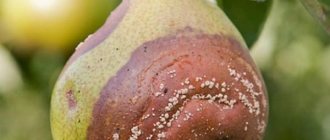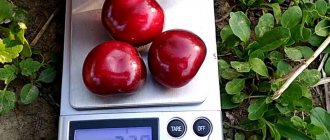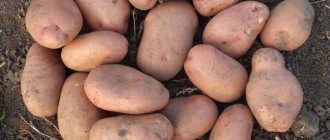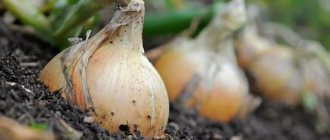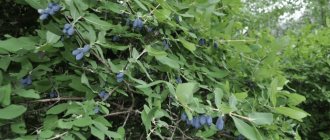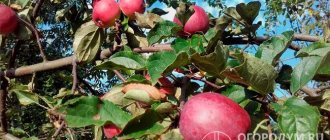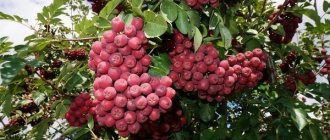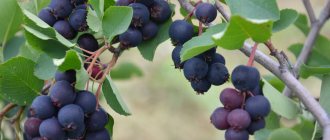Rowan is not only a magnificent tree, but also very useful berries, sometimes undeservedly deprived of the attention of gardeners. From an aesthetic point of view, rowan is attractive at any time of the year: when it blooms, when berries are ripening among the green foliage, or when the foliage has long been gone and there is snow on the berries. Well, rowan berries contain a large amount of vitamins and microelements; they are extremely useful. In particular, housewives make jam, jelly, marmalade from Pomegranate rowan, make delicious compotes and juices, as well as excellent homemade wine. Rowan Pomegranate sorbus granatnaja, what its strengths and weaknesses are, as well as how to care for the tree to get an excellent harvest.
Description of the variety of mountain ash Garnetnaya
Rowan Pomegranate is the result of the breeding work of Michurin I.V., who crossed the Siberian hawthorn and the common rowan. The resulting hybrid was named Crataegosorbus Michurin (hawthorn). Later, thanks to its dark garnet-colored berries, the variety was named Rowan Pomegranate (photo).
Pomegranate rowan is a tall tree with a spreading crown, which has some similarities with the common rowan. The hybrid is characterized by a short duration of industrial cultivation, frost resistance and high adaptive qualities. The tree's shoots are resistant to high and low temperatures and also ripen well.
The variety belongs to light-loving crops, but it can fully develop and bear fruit when growing in shaded areas. Pomegranate rowan stands out from a number of other varietal red fruits due to the size of the berries and their original color. The decorative beauty of the tree is preserved all year round, including in winter.
Description of the varietal characteristics of pomegranate rowan:
- average fruiting period is 20-25 years;
- height of an adult tree – up to 3-4 m;
- the crown is thick, wide, decorative;
- spreading branches;
- foliage is imparipinnate, consisting of several shield-shaped leaves;
- mixed type of fruit buds;
- type of root system – fibrous;
- the flowers are small, white, collected in semi-oval inflorescences;
- the shape of the fruit is spherical, with small edges;
- the color of the berries is burgundy-garnet, with a slight bluish tint;
- average fruit weight 1-1.6 g;
- yield 20-25 kg per season;
- the taste of the berries is sweet and sour, with a light, pleasant note of tartness;
- The pulp of the fruit is dense and yellow.
How to order flowers for delivery?
Do you have rowan trees on your property? We hope that we have convinced you of the usefulness of this crop and you will find a place on your site for the beautiful mountain ash. Everyone loves this slender, elegant beauty. In spring it pleases us with its snow-white flowers with an almond scent, and in autumn it attracts us with clusters of red-orange fruits. And its foliage, changing color at this time from yellow to red, is also very elegant. Remember S. Yesenin: “A red rowan fire is burning in the garden...”
The word "rowan" is often used together with the word "bitter". Indeed, rowan fruits lose their bitterness only after frost or special processing. But few people know that rowan can also be sweet-fruited. The most famous variety of such rowan is Nevezhinskaya.
Gardeners who decide to grow sweet rowan should take into account that many of its varieties require cross-pollination and therefore it is better to grow 2 - 3 trees of different varieties on the site.
There are 80 species of rowan known on the globe, and here we have 34. Of these, the most common is the common rowan. It grows in the forest and forest-steppe zones of the European part of the country, in the Caucasus in the mountain-wooded zone and in the mountainous Crimea.
Rowan can be found in the undergrowth of mixed and coniferous forests, in clearings, along forest edges, among bushes, near reservoirs, on rocky mountain slopes.
Its fruits contain many valuable biologically active substances useful to humans: 4-8% fructose, glucose, sorbose, sucrose; up to 2.7% acids (grape, citric, malic, succinic), pectin and tannins; vitamins - up to 200 mg%, including more ascorbic acid than in lemons, carotene - 5.5-20 mg%, vitamin P and bitter substances: the fruits contain flavonoids. The seeds have 22% fatty oil and the glycoside amygdalin.
In medical practice, rowan fruits are used mainly for vitamin deficiencies in the form of a water infusion or tea (to prepare the infusion, 1 teaspoon of the fruit is brewed with a glass of boiling water and drunk 1/2 cup 1-3 times a day). The fruits are also included in vitamin teas. Vitamin syrup, vitamin concentrate, canned with sugar - you can’t make anything from the fruits of this plant! In addition, in the winter-spring period, when the diet lacks vitamins, we can widely use dried and canned fruits.
In folk medicine, rowan fruits and flowers are used for dysentery. Decoctions of dried fruits are used as a diuretic and hemostatic agent. There is evidence that the fruits have an antibiotic effect.
Rowan is widely used in the food industry and in everyday life, processed into jam, wine, liqueurs, liqueurs, confectionery fillings, marmalade, vinegar, and kvass.
Possessing a whole range of valuable qualities, rowan deserves the closest attention of amateur gardeners. Now there are many interesting varieties of rowan - high-yielding, winter-hardy, with large fruits and excellent taste. These are Nevezhinskaya rowan and hybrids bred with her participation, varieties of I.V. Michurin (Granatnaya, Likernaya, Dessertnaya, Burka) and his followers - A.S. Tikhonova (Titan, Krasavitsa, Rubinovaya) and T.K. Poplavskaya (Alaya large).
Rowan varieties
Beauty
Beauty . The variety is medium-sized (5 - 6 m). The wood is winter-hardy. The leaves are quite large and strongly wrinkled. Flower buds are slightly winter-hardy. The fruits are edible, medium in size (up to 1 cm in diameter) or large, yellowish in color, juicy, sweet and sour with noticeable bitterness, close in taste to the fruits of the rowan.
Grenade
Pomegranate . Hybrid of mountain ash and hawthorn. The tree is not tall, 3-4 m, with a sparse crown, the leaves are pinnately dissected in the upper part, elliptical in the lower part. The variety is winter-hardy and productive.
Burka
Burka . A complex hybrid of alpine sorbaronia and mountain ash. It begins to bear fruit at 2-3 years of age. The tree is short, 1.5–2.5 m. The crown is compact. The leaves are simple, odd-pinnate. The variety is highly winter-hardy. The yield is annual and stable; 40–60 kg of berries can be harvested from 1 plant. The taste is only slightly inferior to Dessert. The fruits are medium-sized, red-brown, slightly tart. Stores well for 3-4 months.
Scarlet large
Scarlet is large . The variety was obtained by pollinating Moravian rowan with a mixture of several varieties of pear. A vigorous tree with a spreading crown. The leaves are large, odd-pinnate. The variety is winter-hardy, high-yielding (up to 150 kg per tree), bearing fruit annually. The fruits are large (1.5 g), orange-red in color. Sugar content is 7-9%, acids - 2-2.5%. Used in processing.
Bead
Bead . A very interesting new variety bred by T.K. Poplavskaya, which tastes like cranberries. The variety is still little known to gardeners, but deserves special attention.
Nevezhinskaya
Nevezhinskaya . A variety of folk selection. The tree is powerful, compact, spherical, highly winter-hardy. Productivity up to 80 - 100 kg. The fruits are large, red, with orange juicy pulp, a pleasant sweet and sour taste without bitterness or astringency, ripen in the first half of September, are stored fresh until April, and stay on the tree all winter without losing their taste.
Ruby
Ruby . Hybrid of pear and rowan. Productive, drought-resistant. Tree of medium height. The fruits are medium in size, dark burgundy in color, and have a sweet and sour taste.
Titanium
Titan . The variety is early-bearing, vigorous-growing. Fruiting is abundant, annual. The fruits are large, juicy, and have good taste.
The varietal range of rowan is quite diverse; there are also hybrids with chokeberry, medlar, pear and hawthorn.
Now some tips on propagating and growing rowan.
Before you start planting plants, you need to familiarize yourself with some of the features of mountain ash. Cultivated varieties of rowan are self-sterile and require cross-pollination, so at least 2 varieties must be planted in the garden. You can limit yourself to just one, if it is turned into a “garden tree” by re-grafting with cuttings of other varieties. Rowan is also characterized by parthenocarpy, i.e. the formation of ovaries without fertilization, but this phenomenon is quite rare.
Plants of low-growing varieties (Burka, Dessertnaya, Titan) should be planted at a distance of 2-3 m from each other. They begin to bear fruit early, in the 2nd–3rd year, and quickly increase their yield, which reaches 15–40 kg of fruit per tree. Vigorous varieties (Nevezhinskaya, Krasavitsa, Alaya Krupny) are planted at a distance of 5-6 m; subsequently they must be carefully shaped, limiting the number of skeletal branches. In adulthood, 100–150 kg of fruit can be harvested from 1 plant of vigorous varieties, but they begin to bear fruit later (from 4–5 years old) and increase their yield more slowly.
The lifespan of rowan plants can be 80-100 years, but the productive age of most varieties is limited to 25-30 years. It is known that the age of plants affects the level of vitamin accumulation: the fruits of young trees, as a rule, contain less vitamins than plants that have reached the productive period.
Most varieties of rowan tolerate winter temperatures dropping to 45-50 °C. Rowan begins its growing season relatively early, at fairly low average daily temperatures. It blooms in mid-late May, 6-10 days later than apple and pear trees, at an average daily temperature of 12-15 °C. Rowan “escapes” late spring frosts, although the flowers are able to withstand temperatures as low as -2.5 °C. In terms of flowering times, different types and varieties of rowan under the same conditions differ little from each other, so their mutual pollination is possible. The flowering time of one variety is 6-10 days. But the fruits do not set well if the weather during the flowering period is rainy or too hot.
In rowan, the flower buds that provide next year's harvest are formed earlier than in most fruit crops. This process begins in early June and coincides with the formation of the current year’s fruits, so during this period the plants must be provided with a sufficient amount of nutrients and moisture. Rowan has a short growing season (140-175 days), leaf fall ends early, and the plants go into winter with well-formed flower buds and mature wood.
Rowan is a flexible, unpretentious plant. A variety of soil and climatic conditions are suitable for it, but plants grow and develop better in well-lit areas with fertile, moisture-absorbing and breathable soil. Protection from winds is not of great importance for rowan; pollination of flowers and preservation of ovaries are the same in both protected and open areas. Rowan does not tolerate prolonged stagnation of water; the bark becomes damp and the roots are damaged.
Rowan can be planted both in autumn and spring. Planting pits for vigorous varieties are prepared with a diameter of 100 cm and a depth of 60 cm, for low-growing varieties, 80 and 50 cm, respectively. If the planting pits are well filled with fertilizers in the first 2-3 years after planting, you can limit yourself to applying only nitrogen fertilizers (30-40 g/m2). During the period of full fruiting, the rate of organic fertilizers is 8-10 kg/m2. Tree trunk circles can be kept under black fallow or covered with sod.
Light rejuvenating pruning of rowan can begin when the growth on the tree noticeably decreases, but not less than 10-15 cm, and the harvest is still relatively high. Heavy pruning is carried out when the average growth length becomes less than 5-6 cm or there is no growth at all. Skeletal and semi-skeletal branches are rejuvenated to 5-6 year old wood.
Rowan is usually propagated by grafting. Rootstocks can be grown from seeds. Freshly harvested seeds sown in the ground in late August - early September germinate well. Rootstocks of apple, pear, quince, hawthorn and chokeberry were studied as rootstocks for rowan. More viable rowan grafts were obtained on chokeberry (aronia).
Some varieties of rowan can be propagated by green cuttings in greenhouses with artificial fog (except for varieties of Nevezhinsky rowan). Good rooting was achieved in the varieties Granatnaya, Dessertnaya, Burka, Rubinovaya, etc. Green cuttings taken from annual growths during the period of their active growth, i.e. from May 10-15 to June 5-10, root better.
We hope that we have convinced you of the usefulness of this crop and you will find a place on your site for the beautiful mountain ash.
Excellent(5)Bad(0)
Pros and cons of the variety
Advantages of red mountain ash variety Granatnaya:
- resistance to high and low temperatures;
- lack of bitterness in fruits;
- berries, leaves and bark contain a large amount of useful substances;
- high productivity;
- large fruit;
- self-fertility;
- precociousness;
- long-term storage;
- The fruits are suitable for drying and freezing.
Disadvantages of pomegranate rowan:
- short tree life cycle;
- average resistance to diseases and pests;
- sensitivity of roots to damage;
- fear of strong winds, which is especially dangerous during the establishment period.
Advice! Moles pose a threat to rowan roots, so the soil around the tree should not be dug up deeply. It is recommended to mulch the tree trunk circle during planting.
Landing rules
Cultivating rowan of the “Granatnaya” variety in home gardening is quite simple. It is enough to take into account some of the characteristics of the plant and comply with the requirements for caring for berry crops:
- areas allocated for growing this garden crop should be represented by soddy-slightly podzolic loams and enriched with organic matter;
- there should be no stagnation of moisture on the site, and the optimal values for the occurrence of groundwater are 1.5−2 m from the surface;
- It is recommended to plant rowan seedlings in the autumn or very early spring, even before the buds bloom on the plant;
- when digging planting holes, you should focus on the size of the root system of the seedling, as well as the depth of the root collar by about 4-5 cm;
- the distance between seedlings cannot be less than two meters, and the best option is planting along a fence or wall of a building.
Planted plants should be watered abundantly, and the tree trunk circle should be mulched with sawdust or peat.
Useful properties of Pomegranate rowan
Rowan pomegranate is considered a medicinal plant. Its fruits, leaves and bark are used for the treatment of many diseases and for preventive purposes. Healing tinctures and decoctions are prepared from them. But before starting treatment with pomegranate rowan, you need to familiarize yourself with its beneficial properties and possible contraindications.
The fruits of rowan pomegranate are 80% water, but despite this, they contain a large amount of carbohydrates, proteins and organic acids (citric, malic and grape). They also contain essential oil, minerals and vitamins (B1, B2, C, A, P, E, K). For example, there is more vitamin C in pomegranate rowan than in lemons. And in terms of the amount of carotene, rowan berries are ahead of carrots. The chemical composition is complemented by macro- and microelements such as phosphorus, magnesium, potassium, iron, as well as flavones, tannins and pectin substances.
Warning! Due to the high content of organic substances, it is not recommended to use pomegranate rowan for people suffering from ulcers and gastritis with high acidity. Pregnant women should consult their doctor before eating berries about the advisability of including them in their diet.
Rowan pomegranate has a beneficial effect on the human body, so recipes based on it are often used to treat many diseases. The main beneficial properties of the plant are its ability to:
- improve blood clotting;
- reduce blood pressure;
- normalize cholesterol levels;
- remove toxins and heavy metals;
- regulate the functioning of the gastrointestinal tract;
- improve the functioning of the thyroid gland and liver.
Application
In cooking
Pomegranate rowan is sweet-fruited, distinguished by tasty, juicy berries. They can be canned and frozen, dried and prepared in a variety of delicious ways - jam, marmalade, compotes and juices, syrup, tinctures, liqueurs, liqueurs and wines.
In medicine
Pomegranate rowan has many medicinal properties. Its fruits, bark, and leaves are actively used by folk healers. Products made according to time-tested recipes have an effect on the body:
- improve blood clotting;
- lower blood pressure;
- promote the removal of toxins and heavy metals from the body;
- help normalize cholesterol levels;
- have a positive effect on the activity of the gastrointestinal tract;
- improve the functioning of the liver and thyroid gland.
When losing weight
To lose weight, use a bottom diet, in which one of the main components is rowan berries. The diet is designed for 14 days, the expected weight loss is up to 7 kg.
Application of Pomegranate Rowan
Rowan Pomegranate is a variety with edible and tasty fruits that can be canned, frozen and dried. From berries you can prepare:
- juices;
- compotes;
- jelly;
- syrups;
- jam;
- jam;
- liqueurs;
- liqueurs;
- tinctures;
- guilt.
Advice! Pomegranate rowan berries are not eaten raw. It is preferable to heat treat food before consuming it.
What gardeners say: reviews
From personal experience I will say: you shouldn’t pick berries as soon as they start to turn red. Wait for a slight frost. Once frozen, the berries become even sweeter.
By the way: do not plant this bush behind the house. This culture should not be hidden. Even when the tree is young and the berries have not yet set, at the end of autumn it will decorate the yard with its crown painted in noble golden tones:
Friends who once recommended this tree to my husband also said the following:
- if you don’t forget about timely watering during times of drought, you will not have problems with this crop;
- this wood does not burn, so some people make a kind of protective barrier out of such trees, especially if there are many wooden buildings in the yard;
- If you already have a rowan tree on your property (only a wild one), graft a couple of pomegranate branches onto its stem - the resulting tree will be especially strong and viable.
The benefits of such rowan: several successful recipes
Pomegranate rowan is a variety with sweet, edible berries. Even if in the video below you see berries of other colors, rest assured, pomegranate is also suitable for preparing all these dishes and drinks!
Healthy and rich in vitamins: red rowan syrup . It can be added to tea, sweetening it and saturating it with vitamins. You can use it to cook jelly, compotes, fruit drinks, and make jelly. Finally, adding vodka here will make a flavorful liqueur:
Pear jam with rowan berries . A successful recipe, the berries don’t fall apart, the jam turns out both tasty and beautiful:
a herbalist says about this culture . Plus a recipe for the right jam from a specialist:
Planting and caring for Pomegranate rowan
Rowan pomegranate is an unpretentious garden crop to grow, but requires systematic care. Trees love light and need regular watering, loosening, periodic but not frequent fertilizing and mulching. Carrying out all the necessary agrotechnical measures will allow you to get healthy, fully developing trees and a good, stable harvest.
Advice! In early spring, the soil near the trunk must be loosened to help the tree awaken. Do not go deeper into the soil than 15 cm, so as not to damage the root system.
Preparing the landing site
It is best to choose a sunny site for planting pomegranate rowan. It can grow in shaded areas, but the yield may be significantly reduced. The soil must be nutritious and well drained. The following soil types are suitable for this variety:
- turf;
- soddy-slightly podzolic;
- loamy.
Attention! Garden pomegranate rowan grows poorly and develops in waterlogged soils. Therefore, you should not plant young trees in lowlands, in flooded areas with high groundwater levels, swampy and stagnant areas.
Rules for planting rowan pomegranate
It is recommended to plant pomegranate rowan seedlings in the ground in the fall, and then it is best to purchase planting material. Spring planting is also possible, but the trees should be planted before the buds begin to bloom.
Step-by-step process for planting pomegranate rowan:
- Prepare a planting hole 1 m wide and 0.5 m deep.
- Place a mixture of fertilizers in the hole (superphosphate - 350 g, potassium sulfate - 250 g, humus - 20 kg) and mix well with the lower layer of soil.
- The seedling is placed in a hole. The root collar should not be more than 5 cm below ground level.
- Fill the hole with soil, lightly compacting it.
- Water the seedling abundantly (water consumption is about 20 liters).
- Mulch the tree trunk circle. The thickness of the mulch layer should be at least 8 cm.
Comment! The distance between several pomegranate rowan seedlings should be no less than 2-2.5 m. The best mulching material for pomegranate rowan is a mixture of compost and wood ash.
Watering and fertilizing
Pomegranate rowan responds well to watering, but stagnation of water can be disastrous for it. Therefore, it is necessary to water trees only during a long dry period. If there is enough rain, adult trees are watered:
- in early spring, during bud break;
- 3 weeks before the berries ripen;
- 30 days after harvest.
Watering is carried out in the area of the tree trunk circle, in specially created grooves. Water consumption per 1 adult tree is about 30-40 liters. After each watering, it is recommended to fluff up and mulch the soil under the mountain ash. Loosening will prevent possible stagnation of water, and mulching will help keep the soil moist for as long as possible.
The amount of fertilizing depends on the age of the plants. Young rowan pomegranate trees are fed once - in the spring, while digging up the soil. More mature specimens need 2 feedings - both in spring and autumn.
The following fertilizers are applied to the soil (per 1 plant):
| Young animals (up to 3 years old) | Mature trees |
| Ammonium nitrate or urea – 25 g | Superphosphate – 50 g Potassium – 30 g |
Trimming
Pomegranate rowan is recommended to carry out the following types of pruning:
- sanitary – for the purpose of removing broken, dry, damaged or diseased branches.
- formative, involving thinning of the crown and elimination of root shoots and lower branches.
Proper crown formation can significantly increase the yield of rowan trees. In the first year, pomegranate rowan is cut to one bud. The procedure is carried out in early spring, before they bloom. It is necessary to monitor the angle of departure of the branches. It shouldn't be too spicy. Mature trees are pruned as needed, thinning the crown, removing excess branches and cutting them by 1/3.
Preparing for winter
In terms of winter hardiness, rowan takes one of the first places among other fruit and berry trees. It tolerates harsh winters quite well, withstanding temperatures down to 50 °C. Therefore, there is no need to carry out any measures related to the insulation of trees. Preparation for winter only involves carefully digging up the soil after harvesting.
Pollination
Rowan Pomegranate is a self-fertile variety, therefore, in principle, it does not require pollination. But cross-pollination can significantly increase yields. Most often, gardeners cross red pomegranate rowan with the following varieties:
- Sorbinka;
- Dessert;
- Bead;
- Wefed.
Attention! Under no circumstances should you use wild varieties for cross-pollination. The wild berries are small, with a bitter and tart taste. Therefore, the result of such a crossing may be negative.
Harvesting
Pomegranate rowan is a fast-growing variety. Already in the 4th year after planting, the trees begin to bear fruit. The berries begin to ripen at the end of August. The variety has high yields, which is about 15-25 kg per tree. The maximum shelf life of fruits in dry, cool rooms is 5 months.
Care
Watering and loosening
Rowan Pomegranate likes to grow on moist soil, but does not tolerate strong stagnation of water. In the absence of precipitation, rowan should be watered three times. Watering is carried out according to the scheme:
- The first watering is carried out at the beginning of the growing season;
Watering Pomegranate Rowan is carried out according to the diagram
- The next watering is carried out approximately 17-21 days before harvest;
- The last watering occurs approximately 21-28 days after harvest.
Watering should be done in the area in the grooves that run around the trunk. For 1 sq. meter will require about 30-40 liters of water.
Be sure to loosen the soil well after each watering, this will allow you to retain the right amount of water in the soil. In addition, it is recommended to loosen the soil in early spring and autumn , in preparation for winter. It is recommended to dig the soil no deeper than 15 cm, so as not to harm the roots.
Trimming Features
Trees must be pruned as they grow. Sanitary and formative pruning is carried out.
Trimming Features:
- In spring, trees begin to grow earlier, so pruning should be done before the buds swell ;
Pruning scheme for pomegranate rowan
- Young plants are shortened by 1 bud, shoots are removed, due to which an acute angle is formed;
- For mature trees, pruning is done as needed. It is usually done to shape the shape of the crown, as well as to thin it out;
- All lower branches and shoots near the roots are cut off ;
- Other branches are shortened by 1/3.
Features of the fertilizer
If during planting fertilizer mixtures were added to the planting hole, then during the first three years pomegranate rowan should be fertilized. In spring, while digging the ground, it is necessary to add 25 grams of ammonium nitrate or urea. From the fourth year of life , in addition to spring, fertilizing is done in autumn. In the autumn, during digging, 50 grams of superphosphate and 30 grams of potassium are added to the soil.
Diseases and pests
The resistance to diseases and pests of the Pomegranate mountain ash variety is quite low. Therefore, it is very important to carry out preventive protective measures in a timely manner, and in case of damage, carry out the necessary treatment.
| Diseases and pests | Signs | Preventive measures (treatment) | Treatment | Period |
| Rowan gall mite | Damage to foliage, appearance of swellings (galls) | Solution 0.1% "Rogora-S" (1 l per 1 m2) | Colloidal sulfur – 1% solution | Before flowering |
| Rowan moth | Goose damage to berry pulp | Digging up the trunk circle. Collection and disposal of damaged berries | in autumn | |
| Chlorophos 0.2% (20 g/10 l water) | 14 days after the start of flowering | |||
| Rowan aphid | Leaf deformation | 2% nitrafen solution (300 g/10 l of water) | 0.2% solution of karbofos (75 g/10 l of water) | In summer, before fruit set |
| Powdery mildew | White coating on leaves | Picking off and burning all affected leaves. Treatment with colloidal sulfur solution (30 g/10 l of water) | Before flowering | |
| Soap-soda solution: 10 liters of water, 3 tablespoons of baking soda, 3 teaspoons of liquid soap | Every 4 days, until the symptoms of the disease completely disappear | |||
| Moniliosis | Damage to the entire tree, appearance of dark gray growths | Damaged parts of the tree are cut and burned | nitrafen (300 g/10 l of water) or copper sulfate (100 g/10 l of water) | Before the buds open |
Rowan Pomegranate - an unpretentious variety with large berries without bitterness
Every second experienced gardener is familiar with the beneficial properties of Pomegranate Rowan. The trees are distinguished by their decorative beauty, and the berries are effective as a medicine for many diseases. Thanks to their rich color and large size, the fruits of Granatnaya have gained popularity among owners of private plots. And its unpretentiousness in care allows you to grow this amazing variety of rowan without much effort.
Reproduction
Pomegranate rowan propagates by grafting or budding (cuttings, arc layering or root suckers). It is best to carry out budding at the end of July in order to be able to prune the grafted plants in mid-spring (April). To prevent the trunks from being twisted, pruning should be done on a spike. The resulting cuttings can be grafted onto ordinary rowan in the spring, thereby ennobling it and improving its varietal qualities.
Grafting of pomegranate varieties can be done in the following ways:
- into the cleft;
- in a side section;
- in the butt.
Comment! Usually the cuttings grow together well, without the formation of any large thickenings at the junction.
Reproduction by arc layering is carried out as follows:
- The lower branches bend to the ground.
- Secure with pegs. The end of the branch should be slightly curved.
- The branch is sprinkled with soil.
It is necessary to ensure that the soil is always well moistened and loosened. You can separate the cuttings from the tree after 2-3 years.
Garden rowan Pomegranate: care
Rowan pomegranate: photo of an adult tree
Like most plants, the hybrid Pomegranate garden rowan does not tolerate stagnant water (that is why we laid a drainage layer at the bottom of the planting hole), but it also needs the soil in the tree trunk to be moistened. Usually, precipitation is sufficient to keep the soil moist, but in the event of abnormal heat and a complete lack of rain, the following procedure must be followed:
- Water the rowan at the very beginning of the growing season.
- The second watering should be carried out approximately three weeks before the expected berry picking.
- The third watering is carried out three to four weeks after the harvest is harvested.
It may seem to some that three waterings is very little. But in this case, it must be taken into account that when watering, approximately forty liters of water must be used for each square meter of the tree trunk circle - this is enough for the plant to grow comfortably.
A day after watering, the soil around the tree trunk must be loosened to avoid the formation of a dense crust on its surface and to improve air permeability. In autumn and early spring, the soil around the tree trunk can be dug up to a depth of fifteen centimeters, but this must be done very carefully so as not to harm the roots of the rowan.
Every year you need to do pruning, which can be divided into two types: formative and cosmetic. Cosmetic pruning is done as needed: branches damaged by disease or pests, broken or frostbitten, and root shoots are removed.
Formative pruning of the hybrid rowan Garnet is carried out in early spring according to a certain pattern in order to correctly form the crown of the rowan. The branches of young trees are shortened by one bud, and shoots that form an acute angle are also trimmed. If the tree is already mature, then pruning is carried out in order to avoid excessive thickening of the tree crown, which inevitably leads to diseases and a decrease in yield.
During the planting process, you prepared a nutrient mixture that included humus, as well as phosphorus and potassium fertilizers - this will be enough for the tree for the first two to three years. After three years, it will be necessary to fertilize twice a season, using mineral fertilizers. In the spring, when digging up the soil around the mountain ash, you need to add urea or ammonium nitrate to the soil. And during similar work in the autumn months, it is necessary to add potassium and superphosphate to the soil.
Rowan Dodong: care
Rowan Dodong: photo
After planting a tree, it requires simple agrotechnical care, which will allow the mountain ash to grow and develop faster.
How to water the mountain ash Dodong
A young Dodong plant must be watered regularly, since their roots cannot independently provide the plant with the required amount of water; rowan is a very moisture-loving crop.
Mature Dodong rowan is already more resistant to drought, which means that they are watered very rarely - only if necessary.
As mentioned earlier, mulch allows you to retain moisture around the plant, so in order to water the plant less often, use mulch (sawdust, straw, coconut fiber and others).
Top dressing
Be careful when feeding young rowan plants with nitrogen fertilizers - they will prevent the development of the plant's root system. Therefore, it is strongly recommended to avoid nitrogen-containing fertilizers in the first couple of years of the plant’s life.
It is also recommended to add mineral fertilizers no earlier than 3 years after planting rowan trees. This fertilizer is applied three times a season.
Before feeding rowan, be sure to study the scheme and recommendations for applying mineral fertilizer:
- before the flowering period, a combination of urea (20 grams), superphosphate (25 grams) and potassium salt (15 grams) is used as fertilizing;
- in the summer season, use a mixture of the following fertilizers: nitrogen (if the plant is older than 3 years), potassium and phosphorus - all products are added in the same volume. 30 grams of mixture are needed per square meter;
- in the fall, use superphosphate and potassium mixture. It is necessary to use 10 grams of each fertilizer per 1 square meter of land.
Fertilizers are applied to the trunk ring, after which the place needs to be dug up, after which the soil is watered abundantly.
Trimming
Rowan Dodong necessarily requires formative and sanitary pruning. Formative is cutting off the crown of the rowan tree according to the design idea, so that the Dodong rowan tree fits into the landscape design in the best possible way.
Sanitary pruning is the removal of broken, deformed, insect-damaged shoots, as well as dense branches. Sanitary removal is carried out in spring and summer.
Also keep in mind that the plant develops a large basal growth - it needs to be dealt with and done in a timely manner. To prevent root growth, you need to regularly loosen the soil in the tree trunk circle, the loosening depth is at least 5 centimeters.
Rowan Dodong: winter hardiness zone
As noted earlier, Dodong rowan is frost-resistant, but it is recommended to mulch the tree trunk while the plant is young. Sawdust and peat are most often used for mulch. In order to reliably protect the root system of a tree from frost and possible freezing, a minimum of 15 centimeters of mulch is required.
Pollination
The Dodong rowan variety is partly self-fertile, which means that there is no need to plant special varieties that act as pollinators. As gardeners note, when rowan grows in conditions of collective planting, Dodong rowan bears fruit more generously than when it grows alone - that is, it is advisable to plant several trees of different varieties at once.
Types of rowan. Popular types and varieties of rowan
The rowan bush or tree belongs to the Rosaceae family. There are about a hundred of its species in the world. Rowan grows in North America, Europe and Asia.
Ruby rowan
Medium height plant. The length reaches from 3 to 4 m. The average weight of the fruit of such rowan is 1 – 1.5 g. The berries have a flattened shape and yellow flesh. They taste sweet and sour. The leaves are small in size, pointed at the ends, and have a light green color. The tree is resistant to low air temperatures, which makes it possible to plant it in regions with harsh climates.
Rowan Titan
A medium-sized tree obtained by crossing varieties of rowan, apple and pear. The culture has a branching crown of a brown hue. The fruit is oblong and has a dark cherry color. A light white tint is visible at the end of each berry. The pulp is bright yellow, not dense. The taste is very pleasant and delicate, with a slight sourness and a pear aftertaste. The leaves have a medium oblong shape, pointed at the edges. The color of the plates is dark green.
Rowan Vefed
The tree is of medium height. At maturity it reaches about 4-5 m in height. The crown has a spherical shape. The shoots and trunk are brown. The fruits of the tree weigh a maximum of 2 g. They are round in shape and purple in color. Ripe berries have a pronounced sweet and sour taste. The first fruiting is observed in the 5th year of the tree’s life.
Rowan Bead
The tree does not exceed a height of 3 m. The crown has a roundish shape and is small. The branches are gray-brown in color, abundantly covered with colorful leaves. Medium sized shoots. The leaves are rounded and pointed at the edges. All plates have a rich green color. The fruits of the tree are brownish-purple. The taste is tart-sweet with a slight sour aftertaste. The tree tolerates low temperatures well and does not require special care. Due to its high characteristics, Businka rowan is often used for planting in the northern regions of the country.
Rowan Vefed has the highest degree of productivity.
Mountain ash
The tree can reach six meters in height. It has a medium rounded crown. Rowan fruits are dark and large. Liqueur liqueur differs from other types in its berries, which have high taste qualities. They taste sweet, slightly tart with a complete lack of acid. Tree of average productivity. It also begins to bear fruit in the fifth year of life.
Scarlet rowan
It is a rather beautiful shrub or tree that has a spherical or pyramidal crown. The rowan tree reaches ten meters in height. The tree has a well-developed root system. The leaves are dark green, not paired. The plant is distinguished by abundant and large fruits, collected in handfuls. The berries are sweet and sour, slightly tart. The pulp has a bright yellow tint. In spring, the tree is covered with inflorescences that resemble shield-shaped cones.
An excellent place for growing such rowan will be fertile, chernozem or woody clay soil. For good development, the bush should be periodically watered and fertilized. The tree loves the sun very much, so it should not be planted in the shade. The plant is resistant to high frosts and various diseases.
During flowering, scarlet rowan exudes an unpleasant aroma.
Fairytale rowan
The tree of the variety has medium height. The crown type is oval, abundantly covered with foliage. The bark has a gray tint. The shoots are elongated and straight. Ripe fruits have a red-orange hue. Each berry weighs about 2 g. The taste of rowan is sweet and sour, the pulp is quite dense. The leaves are flat, bright green with a matte tint.
The berries begin to ripen in late autumn. The presented species also perfectly withstands low temperatures and sudden changes in weather conditions. Fairy rowan is unpretentious in care, which allows it to be grown in any soil and area.
Planting rowan
- Soil selection . The soil can be loamy, soddy-slightly podzolic or turfy. It is important that it is well drained.
- Plot . It is advisable that it be sunny - the more shade that gathers over the mountain ash, the less fruit it will produce.
When to plant? It is best to buy seedlings in the fall. However, you can also plant rowan in early spring. But in this case it is important to do it before the buds open.
- Dig a hole about a meter wide and half a meter deep.
- Pour into it 250 g of potassium sulfate, 350 g of superphosphate, about 20 kg of humus (this is about 1.5 buckets). Mix the bottom ball of earth well.
- When placing a seedling in a hole, do not deepen the root collar of the plant deeper than 5 cm.
- Water the tree well. One seedling will require at least 2 buckets of water.
- Mulch the tree trunk circle. The best mulch for rowan is compost mixed with wood ash. They need to be laid at least 8 cm.
- If you are planting several seedlings, leave about 2.5 m of free space between them.
Does this crop need pollination?
In general, no, since this is a self-fertile variety.
However, if the tree is cross-pollinated, the harvest will only benefit from this. Therefore, some gardeners “marry” Granatnaya with rowan varieties such as Vefed, Sorbinka or Dessertnaya.
But you shouldn’t use wild trees - their berries are bitter and small, so such pollination will only spoil your “breed”.
What ornamental plants can it be “friended” with on the site?
If we talk about shrubs, you can plant barberry, viburnum or honeysuckle next to Pomegranate Rowan.
Perennial flowers such as brunners will also look good in tandem with this rowan.
Caring for an adult tree
- Watering . On the one hand, pomegranate likes to grow in moist soil, on the other hand, it is afraid of stagnation of water in the soil. Therefore, it is worth watering only in the absence of rain. The first time - at the beginning of the leaves opening, the second - three weeks before the fruits ripen, and the third - a month after picking the berries. It will take 3 to 4 buckets per meter of tree trunk soil.
- Loosening the soil . After each watering, lightly loosen the soil and sprinkle it with fresh mulch. It is also worth fluffing up the soil in early spring (helping the tree “wake up”) and in the fall, when the harvest has long been harvested. But do not disturb the soil deeper than 15 cm - take care of the roots!
- Feeding . During spring digging, young trees (up to three years of age inclusive) are fed with urea or ammonium nitrate; 25 g of this substance is given per plant. More mature “individuals” need more nutrition. In addition to spring feeding, they also carry out autumn feeding, adding 30 g of potassium and 50 g of superphosphate under the trunk.
- Trimming . The tree undergoes sanitary pruning, removing all dry, diseased, broken branches. Also, this rowan tree undergoes formative pruning - the root shoots are removed, the crown is thinned out. It is worth doing such pruning in the spring, before the buds awaken.
Possible problems
Even a plant with high infection resistance can be affected by disease or be attacked by parasites. The problem can be prevented if preventive treatment of the tree with appropriate preparations is carried out in a timely manner. Well, if the tree is still affected, then it will have to be treated, again resorting to special drugs.
Harmful insects. First of all, you can find rowan aphids on the leaves and young shoots. This is a small pest that feeds on the sap of the plant; the leaves gradually curl and dry out. Any type of aphid spreads very quickly, so you need to regularly inspect the plants and start fighting at the first sign of the pest. As a preventive measure, before the buds appear, you can treat the tree crown with Nitrafen. After the buds appear and bloom, you can use the drug “Rogor-S”, and in the summer, before the ovaries appear, use the “Karbofos” solution. If an aphid infestation is observed during the ripening process, then you can resort to folk remedies, which can be easily and quickly prepared using water and laundry soap, adding to them your choice of soda, pepper, and strong-smelling herbs. It is important to know that in addition to aphids, it is also necessary to immediately begin the fight against ants, since these insects often exist in symbiosis and in order to achieve the desired result, it is necessary to exterminate both of them.
Another unpleasant pest is the rowan moth; its caterpillars feed on rowan berries. To prevent their appearance, a couple of weeks after flowering has ended, treat the tree with Chlorophos, preparing a solution in accordance with the recommended dosage. In order to fight the Rowan gall mite, it is necessary not only to spray the crown of the tree, but also to carefully dig up the soil in the tree trunk circle, removing all weeds and plant debris - this is where pests can overwinter. If you find that a mite has appeared and is damaging the leaves of the plant, then treatment is carried out using colloidal sulfur, but this solution must be used before the rowan begins to bloom.
Diseases of pomegranate rowan The most common diseases of pomegranate rowan are powdery mildew and moniliosis. The first disease manifests itself in the form of a whitish coating on the leaves; as soon as you notice signs of the disease, you must remove all the affected areas, and do not throw them away, but be sure to burn them. After this, treat the crown of the tree with colloidal sulfur (to prepare the solution you will need 30 grams of the substance per bucket of water), and then every three to four days spray the tree with a soap solution with the addition of soda. Moniliosis changes the structure of the plant and provokes the appearance of growths; this disease cannot be cured; all areas of the tree that are affected by the disease must be cut down to healthy wood and immediately burned, and the sections should be treated with garden varnish. As a preventative measure in the spring, before the buds appear, you should spray Pomegranate rowan with “Nitrophen” or copper sulfate.
